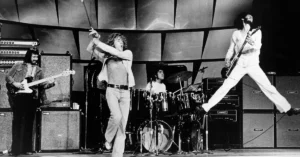Marillion: Pioneers of Neo-Prog and Musical Storytelling
The Formation of Marillion: A New Sound for Progressive Rock
Marillion was formed in 1979 in Aylesbury, Buckinghamshire, England, during a time when progressive rock was in decline due to the rise of punk rock and new wave. The band’s members came together with the intention of reviving the symphonic and concept-driven rock style of earlier prog bands like Yes, Genesis, and King Crimson, while incorporating new influences that would define their own sound.
The original lineup consisted of:
- Fish (real name: Derek William Dick) – lead vocals
- Steve Rothery – guitar
- Pete Trewavas – bass guitar
- Mick Pointer – drums
- Mike Holmes – keyboards
While their initial sound reflected the grandiose, sprawling nature of 1970s prog, it also introduced a more personal and accessible tone, which would help to define the band’s niche in the evolving music scene.
Marillion. The Early Years and Breakthrough: Script for a Jester’s Tear (1983)
1. Script for a Jester’s Tear (1983)
Marillion’s debut album, Script for a Jester’s Tear (1983), was a breakthrough that defined their place in the neo-progressive rock genre. While rooted in the complexity of traditional progressive rock, it also appealed to a more modern audience with its personal lyrics and melodic structures.
The album is recognized for its emotional depth, with Fish’s dramatic vocals and poetic lyrics creating a sense of theatricality and narrative. The opening track, “Garden Party,” is one of the most iconic songs from the album, with its commentary on class, art, and social expectations.
- Key tracks: “He Knows You Know,” “Script for a Jester’s Tear,” “Garden Party”
- Themes of existential doubt, introspection, and societal critique run throughout the album.
Marillion. The Fish Era: Defining a Sound
2. Fugazi (1984)
Marillion’s second album, Fugazi (1984), was a direct follow-up to Script for a Jester’s Tear, maintaining the band’s signature progressive style but incorporating a darker, more atmospheric tone. The album was received positively by critics and solidified Marillion’s place in the UK’s progressive rock scene.
- Key tracks: “Punch and Judy,” “Incubus,” “Fugazi”
Although Fugazi didn’t match the commercial success of their debut, it remained a critically acclaimed and solid offering, showcasing their growth as a band.
3. Misplaced Childhood (1985)
1985 saw the release of Misplaced Childhood, Marillion’s most commercially successful album and a defining moment in their career. The album marked a departure from the more overtly complex and experimental elements of their earlier work, embracing a more accessible, melodic sound while still retaining the band’s progressive roots.
- Key tracks: “Kayleigh,” “Lavender,” “Heart of Lothian”
- Misplaced Childhood reached No. 1 in the UK charts, thanks in large part to the hit single “Kayleigh,” which became one of Marillion’s most enduring songs. This album is considered a masterpiece of 1980s progressive rock, with its exploration of loss, nostalgia, and identity.
Marillion. Post-Fish Era: A New Chapter with Steve Hogarth

4. Season’s End (1989)
In 1988, Marillion experienced a major lineup change when Fish left the band due to creative differences and personal reasons. This left Marillion in a transitional phase, but they found a new lead vocalist in Steve Hogarth. Hogarth, who brought a more modern and atmospheric style to the band, would be a key figure in shaping the direction of the band for years to come.
The first album with Hogarth, Season’s End (1989), marked a new era for the band, with a more polished and emotionally charged sound. The album retained some of Marillion’s progressive elements, but it also incorporated new influences, including more synth-heavy soundscapes and alternative rock tones.
- Key tracks: “The Unquiet Sky,” “Hooks in You,” “Easter”
While Season’s End was a commercial success, it also marked a departure from the band’s earlier, more complex arrangements, signaling the beginning of a more radio-friendly style in their music.
5. Brave (1994)
One of Marillion’s most ambitious works, Brave (1994), is a concept album that tells a story of a woman’s struggle with trauma and the breakdown of her mental health. The album’s dark, atmospheric, and cinematic sound made it an instant fan favorite and cemented the band’s legacy in the progressive rock community.
- Key tracks: “The Great Escape,” “Brave,” “The Hollow Man”
- Brave is considered one of the band’s finest achievements, blending progressive rock complexity with emotional depth, as well as masterful storytelling.
Marillion’s Evolution: From Progressive Rock to Modern Sound
6. Radiation (1998)
In the late 1990s, Marillion continued to evolve with albums like Radiation (1998), which embraced a more stripped-down sound, incorporating elements of alternative rock and electronic music. This era marked a departure from their earlier, more elaborate productions but continued to showcase their exceptional songwriting and ability to adapt.
- Key tracks: “Under the Sun,” “Tumble Down the Years”
7. Anoraknophobia (2001)
By the turn of the millennium, Marillion had found a new creative direction with Anoraknophobia (2001), which saw the band returning to their progressive roots but with a more modern approach. The album’s introspective lyrics and melodic structures represented a mature and evolved band.
- Key tracks: “Map of the World,” “The Invisible Man”
Legacy and Influence
Marillion’s musical legacy is rooted in their ability to blend the complex structures of progressive rock with accessible melodies and deeply emotional storytelling. They are widely regarded as pioneers of the neo-progressive rock movement, influencing many bands that followed in their footsteps.
Their longevity is remarkable, having remained a key force in progressive rock for over four decades. Marillion’s commitment to both artistic integrity and fan engagement has allowed them to continue producing albums and performing to dedicated fans worldwide.
Interesting Facts
- Crowdfunding pioneers: In the 2000s, Marillion was one of the first major acts to embrace crowdfunding, raising money from fans to fund their albums, beginning with Anoraknophobia.
- They have never had a No. 1 album in the U.S., but they have a massive and devoted following in Europe.
- Marillion’s dedicated fanbase has been instrumental in keeping the band alive through tough periods, particularly during their post-Fish years.
- Steve Hogarth, their lead vocalist since 1989, has brought a distinctive, often more vulnerable and introspective tone to the band’s lyrics.






